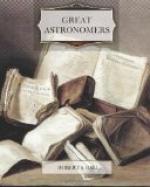comparison, what are we to think of a collection in
which these objects are enumerated in thousands?
In this great catalogue we find arranged in systematic
order all the nebulae and all the clusters which had
been revealed by the diligence of the Herschels, father
and son, in the Northern Hemisphere, and of the son
alone in the Southern Hemisphere. Nor should
we omit to mention that the labours of other astronomers
were likewise incorporated. It was unavoidable
that the descriptions given to each of the objects
should be very slight. Abbreviations are used,
which indicate that a nebula is bright, or very bright,
or extremely bright, or faint, or very faint, or extremely
faint. Such phrases have certainly but a relative
and technical meaning in such a catalogue. The
nebulae entered as extremely bright by the experienced
astronomer are only so described by way of contrast
to the great majority of these delicate telescopic
objects. Most of the nebulae, indeed, are so
difficult to see, that they admit of but very slight
description. It should be observed that Herschel’s
catalogue augmented the number of known nebulous objects
to more than ten times that collected into any catalogue
which had ever been compiled before the days of William
Herschel’s observing began. But the study
of these objects still advances, and the great telescopes
now in use could probably show at least twice as many
of these objects as are contained in the list of Herschel,
of which a new and enlarged edition has since been
brought out by Dr. Dreyer.
One of the best illustrations of Sir John Herschel’s
literary powers is to be found in the address which
he delivered at the Royal Astronomical Society, on
the occasion of presenting a medal to Mr. Francis
Baily, in recognition of his catalogue of stars.
The passage I shall here cite places in its proper
aspect the true merit of the laborious duty involved
in such a task as that which Mr. Baily had carried
through with such success:—
“If we ask to what end magnificent establishments
are maintained by states and sovereigns, furnished
with masterpieces of art, and placed under the direction
of men of first-rate talent and high-minded enthusiasm,
sought out for those qualities among the foremost in
the ranks of science, if we demand QUI Bono?
for what good a Bradley has toiled, or a Maskelyne
or a Piazzi has worn out his venerable age in watching,
the answer is—not to settle mere speculative
points in the doctrine of the universe; not to cater
for the pride of man by refined inquiries into the
remoter mysteries of nature; not to trace the path
of our system through space, or its history through
past and future eternities. These, indeed, are
noble ends and which I am far from any thought of
depreciating; the mind swells in their contemplation,
and attains in their pursuit an expansion and a hardihood
which fit it for the boldest enterprise. But
the direct practical utility of such labours is fully




